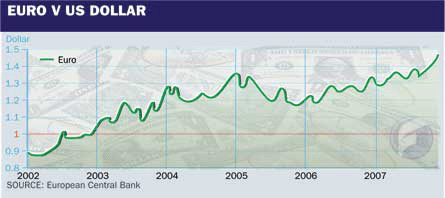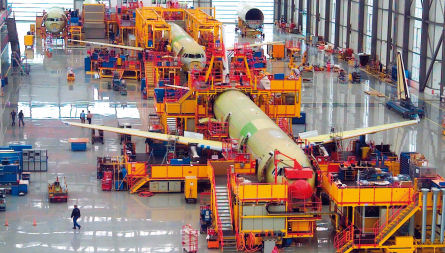Exchange rate pain is real for Europe's main airframer, but threats to move the dollar zone may be political posturing.
It is a tale of two Airbuses. The first Airbus is enjoying runaway success in the market: last month's Dubai air show brought a torrent of sales and the airframer could well end up ahead of arch-rival Boeing when the 2007 order figures are confirmed in a few weeks. It can scarcely build A320 family aircraft quickly enough, with production expected to reach 40 units a month by decade-end (including four aircraft a month assembled in China). A330s are selling faster than they have for some time. Even two programmes that last year seemed a millstone for Airbus - the A350XWB and A380 - appear to have turned the corner, with waiting times for the Boeing 787 helping the A350XWB to 300 orders, and the first A380 finally going into service with Singapore Airlines.
So what of the other Airbus? This Airbus is in crisis: the victim of a weak dollar and locked in a dispute with French and German politicians and unions over its Power8 restructuring plan and the sale of subassembly factories. Louis Gallois, chief executive of Airbus parent EADS, warned last week that the company had "no choice" but to move production outside Europe, possibly to the USA, to cope with the dollar's plunging value (almost all of Airbus's revenues are in the US currency, while most of its costs are in euros). "We're not saying we may have to do this," he told the Europel radio station in Paris. "We're saying we will do this."
So can the threat be taken seriously? After all, Airbus is much more than simply a manufacturing company. It is a product of Europe's post-war determination to create a home-grown aerospace industry and not be eclipsed by the USA's economic might. To export high-tech jobs over the Atlantic is as inconceiveable to many politicians as relocating the Eiffel Tower or Brandenburg Gate to Hollywood. Complicating that is the desire of European governments to retain military capabilities. Although Airbus is a civil manufacturer, products such as the A400M airlifter and even the Eurofighter Typhoon have only been possible because of the industrial know-how held by Airbus's heritage companies.
There are practical problems too. Although the dollar is edging to 1.5 to the euro, currencies can fluctuate. When the European currency was introduced in 2002, the big worry was how low the euro was valued against the dollar. Besides, EADS is hedged at $1.15 per euro for 2008 and at $1.24 in 2009. "That is still painful," says Richard Aboulafia, vice president of analysis with the Teal Group. "But with the exchange rate hovering around $1.45 per euro, it's better than nothing." In addition, setting up greenfield factories in the USA, or elsewhere, takes time. An easier solution might be to simply source more components from dollar-zone suppliers - something Airbus has been stealthily doing over the years - with US-built content making up between 30% and 45% of most Airbus airliners, according to Aboulafia.
 |
|---|
In fact, Aboulafia is convinced comments by Gallois and Airbus chief executive Tom Enders about the "life-threatening" currency situation and that the exchange rate has "passed the pain barrier" are a way of frightening politicians and unions into accepting Power8. "Exaggerating the currency threat to help sell a very necessary corporate restructuring is a smart tactic," he says. Having a pop at the Americans for allowing the dollar to decline - as Gallois did last week - has been a traditional get out for French politicians and industrialists who would rather blame external factors than address shortcomings in their own industrial structures.
Airbus's ambition to reinvent itself as a lean manufacturer, able to compete long-term with Boeing in a global market, depends on it being able to hive off many of its subassembly factories to third parties, something it has been struggling to do for more than a year and where Boeing has been successful. Although this would not involve an immediate massive loss of jobs for European industry - as almost all the Airbus redundancies would be soaked up by the new factory owners - it would reduce the airframer's costs and allow it more flexibility in negotiating with suppliers.
Although these new owners would be free to work for Boeing and others, that flexibility is what frightens unions and politicians. Without the guarantee of Airbus contracts, vital aerospace jobs could be lost over time. In addition, the French government - which retains a 15% shareholding in EADS - and its German counterpart would have much less influence over the smaller businesses bidding to take over the plants: GKN, Latecoere, MT Aerospace, Spirit AeroSystems and Voith - one of which, Spirit, is a US company.
At the heart of it all is the fact that EADS's biggest financial headaches have nothing to do with the exchange rate. A �1.37 billion charge caused by delays to the A400M, and further costs associated with the A350XWB and A380 will all hit its bottom line in 2007. The weak dollar is not the cause of the company's woes, but it is making dealing with them all the harder.
|
|---|
A320 demand is so strong that Airbus can scarcely build them fast enough |
Source: Flight International




















